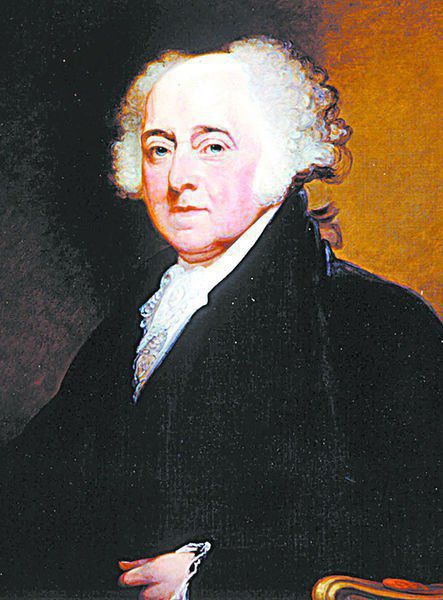Jefferson, Adams: Of friends, rivals
Published 10:00 am Monday, July 4, 2022

- John Adams
John Adams was a prickly soul, possibly the most misunderstood of the Founding Fathers. Thomas Jefferson was a mysterious bundle of contradictions, leading historian Joseph J. Ellis to refer to him as the “American Sphinx.”
Without the friendship and rivalry of these two men, we would not celebrate the American independence we know today. Without them, July 4 would possibly be just another day on the calendar.
Both men were irrevocably linked to each other, the birth of the American nation and fatefully to July 4.
They worked together on the Declaration of Independence. Both Adams and Jefferson were part of a five-man committee whose membership also included Benjamin Franklin, Robert R. Livingston and Roger Sherman. The committee had been appointed to draft a document regarding American independence from British rule.
John Adams felt he was too unpopular within the Continental Congress to write the Declaration. Livingston was an anti-independence man. Sherman had no visible writing skills. Though Franklin was the world’s most famous American and a successful writer and publisher, he felt his son’s loyalty to the king would prejudice congressmen against any document he might write.
Which left Jefferson.
As a Southerner from Virginia and as a talented writer, Thomas Jefferson was the obvious choice to pen the declaration. Adams later claimed to have urged Jefferson to accept the task. Adams would also later exhibit great jealousy that Jefferson was renowned as the Declaration’s author. Especially since Adams has been referred to as the voice of independence.
On July 1, 1776, Adams spoke with passion for independence. He reportedly brought his fellow Continental Congressmen to their feet in Philadelphia. Jefferson later wrote that Adams was “not graceful nor elegant nor remarkably fluent,” yet, he “spoke with a power of thought and expression that moved us from our seats.”
Following his speech, nine colonies voted for independence. On July 2, 12 voted for independence; lacking official instruction, the New York delegation could not vote for the state, but they, too, voted in favor for independence as individuals.
The Continental Congress spent the next two days perusing and editing the Declaration of Independence.
After Jefferson wrote the Declaration on his lap desk in the second story of a house belonging to a German mason named Graff, he approached fellow committee member Benjamin Franklin.
“Will Dr. Franklin be so good to peruse (the Declaration) and suggest such alterations as his most enlarged view of the subject will dictate?”
“After decades as a writer and editor, Franklin knew good prose when he read it,” writes historian H.W. Brands in his book, “The First American: The Life and Times of Benjamin Franklin.” “He treated Jefferson’s draft gently.”
So did Adams. Together, Franklin and Adams made few changes. Congress was another matter. Congress made many changes to Jefferson’s original draft, creating the Declaration we know today.
“… But the Declaration remained Jefferson’s creation,” writes historian Thomas Fleming . “As one historian summed it up, ‘(Jefferson’s) spirit brooded over it, giving light to the whole.’”
Congress had completed the document by July 4 and public readings of the Declaration began that day and in the days following.
As time passed, the Declaration took on the character of “American Scripture.”
Jefferson and Adams’ friendship suffered from the birth of partisanship within the young American government.
Adams served as George Washington’s vice president. Jefferson served as Washington’s secretary of state. Jefferson and Adams had different visions for the United States of America. Their disputes deepened after Washington left the presidency and Adams became the nation’s second President and Jefferson was elected vice president.
Following his election, Adams hinted at making Vice President Jefferson his co-president. Jefferson declined.
During Adams’ presidency, their friendship faded and the two men became deeper political rivals. These one-time bosom buddies became bitter enemies, and Adams and Jefferson refused to speak or correspond for several years.
At the end of his first term, Adams faced his vice president as a challenger. Adams lost a second presidential term to Jefferson. Despite the animosity between the two men, Adams readily followed the people’s will and departed the capital city prior to Jefferson’s inauguration.
Many years after their respective presidencies, Adams and Jefferson rekindled their friendship. They wrote to each other often, with Adams writing an estimated three letters to every one of Jefferson’s.
Adams and Jefferson were uniquely connected to each other and July 4.
By 1826, Adams and Jefferson were two of only three survivors who signed the Declaration of Independence. As Americans prepared to celebrate the 50th anniversary of American independence, both Adams and Jefferson were too old and infirm to attend any of the many events marking the occasion.
On July 4, 1826, Jefferson died first. Adams did not know of Jefferson’s death, but Adams too was on his death bed that day.
Shortly before Adams died on July 4, 1826, he reportedly said, “Jefferson survives.”




